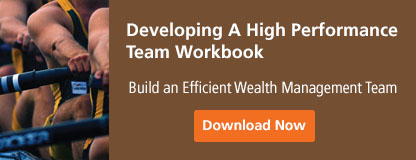Better Understanding Your Financial Advisory Team...

Many financial advisors come to ClientWise seeking the partnership of a coach as they go through the process of growing their teams. While they may need help with the tangible business aspects of this, many are unknowingly seeking advice of a different type. Ultimately, many advisors find that what they really desire to understand are the more human nuances behind building a team, which might not be addressed in the financial advisor workshops they attend, or the industry content they read.
In an era in which the Millennial mindset is affecting financial services in ways that the baby boomers never dreamt, there is a lot of shifting and changing afoot. The difficult part isn’t necessarily in finding team members who can do the job, but in finding team members who also resonate with your culture and vision for growth. Understanding whether your team members have this capacity involves a different kind of measurement—one that is determined not only by their technical ability but also by their coachability and personality types.
Get clear on who is coachable: The “best” team members are those who are open to new ideas and willing to partner with their leader or teammates in a collaborative environment. This involves responding positively to feedback, expressing a self-awareness that is capable of identifying gaps in performance, and making change in a positive and measurable way. Ideally, everyone on your team will have these traits, but this is not always the case. Ultimately your team members’ technical skills must come into play as well, but if you’re hiring new team members it’s important to understand that the technical stuff can be taught, while the coachability often cannot.
Understand your team’s habits: While you don’t want the habits of any one team member, or even all your team members, to determine how you run your business, it is important to realize that different people are at their best in different circumstances. You may want to encourage the productivity that comes out of this natural state by doing your best to accommodate your employees. This is especially true of Millennials who have generally proven to be incredibly productive when left to their own devices. How could this scenario impact your team? What situations or environments do your team members respond to? Are they better off having meetings early in the morning or later in the afternoon? Are they better at working collaboratively at certain times of day or certain days of the week? How often do you solicit their opinions? This will give you greater insight and encourage your team members’ involvement in understanding their own habits as they relate to the overall goals of the team.
Use a team assessment or personality indicator: At ClientWise, we use several different types of assessments to better understand our team members and how they work. Our Team Insights 3-6-0™ takes a 360-degree approach to provide a complete picture of the team environment, through complete and confidential employee engagement. Our DISC Assessment™ is an evaluation tool that provides insight into your team members’ natural and adaptable behavior styles, and can be used to assess both individuals and team and how they communicate. Finally, our Emotional Intelligence Assessment provides a key differentiator in determining an advisor or team member’s ability to manage relationships with clients, key advocates, and centers of influence. It’s also a great way to determine someone’s coachability, as are any of these exercises. These are three different tools with the capacity to provide a more complete perspective of the individuals on your team, or the team as a whole. Use them to your advantage. You may invest a little more time up front in implementation, but it will eliminate significant guesswork down the line.
Hire those with a high capacity for understanding: It’s not uncommon to find people who are extremely good at one task, but aren’t so great at seeing how that task fits into the overall larger picture of what they are doing. The best team members will be capable of seeing the whole picture of the business and clearly understanding how their contribution fits into that bigger picture. This is crucial to promoting a sense of collaboration and unity amongst your team. It will also encourage mutual understanding amongst team members, which will lead to greater efficiency and a desire on their part to understand where you are coming from as their leader.
Powerful coaching questions from this article:
- When was the last time you looked at your team members through the lens of their coachability vs. their technical ability?
- How clear are you on how well your team collaborates?
- Regardless of whom you currently employ, what would your ideal team look like?
Topics: Team Development Coaching


